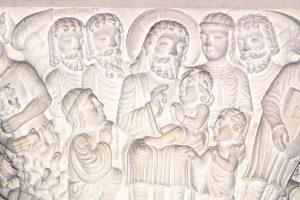I typed the question into the search engine with sincere curiosity: What does the word “O” mean? This wasn’t work avoidance—although I’m a master at that. Advent is here, which means the O antiphons of the season aren’t far behind.
The replies were legion. First up was the contraction for of: a cup o’ joe, a will o’ the whisp.
Then came the Irish shorthand for one’s family of descent: O’Brien, O’Neill, O’Malley.
Followed by o’clock, short for “of the clock.” This distinction has to be made concerning time, since before there were clocks, one knew the hour by the position of the sun. (The sun wasn’t so hot on minutes or seconds, but a ballpark determination of the hour was possible.) Therefore, to say, “It is two o’clock” is to specify that this is the time according to a timepiece. If you’re squinting into the sky, however, better to say, “It’s two-ish.”
“O” can be a blood type. The scientific symbol for oxygen. Or mistaken for a zero.
It’s the letter that makes things slangy: cheapo, bizarro, weirdo, kiddo.
“O” is an exclamation of surprise. It also expresses fear, wonder, pain, annoyance, longing, gladness. It can be a tender address: O my darling. It lends urgency to a speaker’s plea: Hear, O Israel! It also appears a great deal in poetry and song: O Christmas Tree! O beautiful for spacious skies! O Canada! O I wish I were an Oscar Mayer wiener! (If you weren’t alive in the 1970s, please enjoy Julien Neel’s one-man barbershop quartet on YouTube for this last reference.)
Whatever the meaning, the word “O” has been in English-language usage since at least the 13th century. Since 1382, the year John Wycliff wholly translated the Bible into English, the usage of O has sounded biblical and even prayerful. How else do you begin a prayer but with “O God”?
Which brings us finally to the O antiphons: those glorious addresses to the living God that we pray each year at Mass and vespers from December 17 until the 23. If you make a habit of praying evening prayer at home or attend daily Mass, you’re probably familiar with the antiphons. Also, if you’ve ever sung “O Come, O Come, Emmanuel,” you know them even if you didn’t recognize them.
The seven antiphons appear in English and in Latin as:
O Wisdom (O Sapientia)
O Lord Most High (O Adonai)
O Root of Jesse (O Radix Jesse)
O Key of David (O Clavis David)
O Radiant Dawn (O Oriens)
O King of Nations (O Rex Gentium)
O Emmanuel (O Emmanuel)
No extra points for knowing them in Latin, but it does help you recognize them in circles where Latin is the lingua. The antiphons’ ordering varies through the centuries, from the 6th- to 7th-century Latin plainchant original, “Veni, Veni, Emmanuel” through French, German, and English versions of the hymn we know as “O Come, O Come, Emmanuel.”
There is also an eighth antiphon, mostly used in monasteries on the eve of Christmas. This antiphon, utilized for the singing of the Magnificat, reads: O Virgin of Virgins.
Benedictine scholar Columba Kelly explains how monastic dignitaries intoned these “greater antiphons” each evening of the final week of Advent: abbot, prior, and down through the cloister ranks. Each was accompanied by candles lit in a special seven-branch candelabra.
In modern hymn versions of the antiphons, the first verse actually employs the last antiphon of the bunch: O Emmanuel. The rest are shuffled. This is because liturgy and hymnody are grand experiments in blowing our minds. Just kidding. (Although they really are.) Composers included five to eight verses in varied orderings, but in English the verbal backflip of starting with the final Antiphon remained appealing. Liturgical time is, after all, a kind of Möbius loop. These days we’re most familiar with the Möbius loop as a symbol for recycling: three arrows chasing one another’s tails, reminding us that everything has to go somewhere, so let’s keep stuff out of the landfill by reusing it.
The Möbius loop is a modern take on a much more ancient depiction of the ouroboros: the serpent or dragon that appears to swallow its own tail. A symbol for eternity, it also signals that life and death restlessly trade places in the change of seasons. Just consider how matter is neither created nor destroyed but keeps transmuting from one form to another. Decayed matter sets the scene for new growth in the natural world. Water shifts from solid to liquid to gas. Religious traditions that embrace a doctrine of reincarnation view spiritual essence in Möbius fashion, rerouted according to the moral advancement or decomposition of the present host.
While Christianity views physical death as an end to our existence in time, it’s no ordinary end. Eternity awaits in various formats resulting from our present moral choosing. We might say everybody has to go somewhere, so you want to be sure you don’t wind up in the landfill.
The seven O titles remind us of this passage. They aren’t arbitrarily chosen but rooted in scriptures, particularly prophecies of Isaiah that trace pathways of hope for humanity. Isaiah says God’s Spirit provides “wisdom and understanding” (11:2–3). The Lord is our judge, ruler, and king (33:22). The “people who walked in darkness have seen a great light” (9:2). The “root of Jesse shall stand as a signal to the peoples” (11:10). God will give one who is to come “the key of the house of David,” the power to bind and loose (22:22). The coming one will “judge between the nations” until “nation shall not lift up sword against nation” (2:4). The young woman will be with child “and shall name him Emmanuel,” God-with-us (7:14).
Other biblical references supporting these titles derive from Genesis, Exodus, Deuteronomy, Jeremiah, Zechariah, Haggai, Sirach, Wisdom, Luke, John, Ephesians, Hebrews, and Revelation.
As I pondered my original question—What does “O” mean?—it seemed I’d come full circle; or full Möbius. The O antiphons really are oh-mazing. They express our mortal longing and pain: O no! They also render the surprise and gladness of a people visited by the God who saves. These are exclamations of tenderness and majesty. They speak of lineage and belonging (the Irish are O so right!) and are elemental as blood and oxygen. They speak of time, its eternal looping through history that repeats, seems to double back, yet moves forward. Like all of liturgy, the antiphons remind us of what we already know in a relentless chant so simple and pure we can’t fail to remember it. They are the refrain of all our hopes that rescue is coming with peace and light, with power and forgiveness, with new life rooted in the past, reaching forward into the promise of the future.
And O it makes me happy to contemplate these mysteries this Advent. O, I can’t wait to sing the antiphons again. O boy. O joy. O brother. O Blessed Mother. So pour me a cup o’ eggnog, someone put on some carols, and let’s get this party rolling.
For more Testaments:
- Malachi offers a stern warning to priestly leadership
- Mary Magdalene knew she was an apostle. Why don’t we?
- What Catholics get wrong about heaven
This article also appears in the December 2023 issue of U.S. Catholic (Vol. 88, No. 12, pages 47-49). Click here to subscribe to the magazine.
Image: Unsplash/Haley Rivera













Add comment